The Search for the Portrait that Belonged to Kittel Pages at The Face Of Bach
The Queens College Lecture of March 21, 2001 - Page 14 - The History of the Weydenhammer Portrait Fragment and The Questions that Remain
to be Answered
The Face Of Bach
This remarkable photograph is not a computer generated composite; the original of the Weydenhammer Portrait Fragment, all that
remains of the portrait of Johann Sebastian Bach that belonged to his pupil Johann Christian Kittel, is resting gently on the surface
of the original of the 1748 Elias Gottlob Haussmann Portrait of Johann Sebastian Bach.
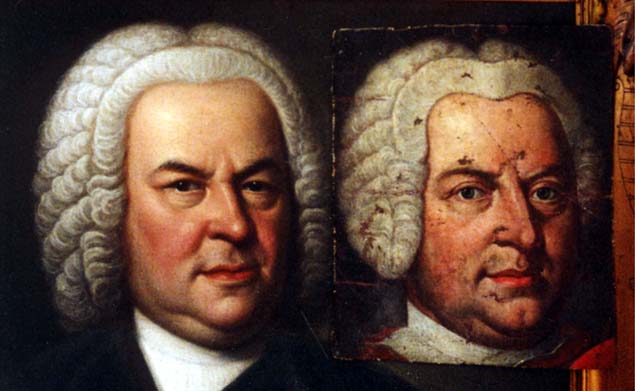
1748 Elias Gottlob Haussmann Portrait, Courtesy of William H. Scheide, Princeton, New Jersey
Weydenhammer Portrait Fragment, ca. 1733, Artist Unknown, Courtesy of the Weydenhammer Descendants
Photograph by Teri Noel Towe
©Teri Noel Towe, 2001, All Rights Reserved
The Search for the Portrait that Belonged to Kittel
The Queens College Lecture of March 21, 2001
Page 14
The History of the Weydenhammer Portrait Fragment
and
The Questions that Remain to be Answered
At the present time we are able with certainty to say only that the Weydenhammer Portrait Fragment has been in the possession of
the Weidenhammer family, which modernized the spelling several decades ago, since at least the mid 1870s, and probably as early
as 1869, and possibly some twenty to thirty years earlier. The first member of the family who we can say for certain had it in his
possession was Edward Weidenhammer, the great grandfather of Erika Norwood and Christina Neumann, the two sisters who
presently own the painting. Edward Weidenhammer, who was born in 1850, came from Querfort (formerly, Querfurt), in Saxony,
where his family had lived for many generations.
If the name Querfort seems familiar to you, it should be. It is the modernized form of Querfurt, one of the components of what was
the Duchy of Sachsen-Weissenfels, or, more completely, the Duchy of Sachsen-Querfurt-und-Weissenfels.
It is not yet possible, however, to determine whether the painting had been a family heirloom that Edward Weidenhammer brought
with him to the United States when he came to Baltimore, Maryland, in 1869, ostensibly to study medicine but really to evade
compulsory military service in the Prussian army. It also is possible that Edward Weidenhammer, who was one of the most
prominent entomologists in the United States in his time, obtained the painting through his wife's family, and he could have acquired
from some close family friends, also emigrants to the United States from Querfort. A limited amount of family documentation and
family history is available, and these materials are currently being gleaned for information. We also hope to establish contact with
distant relatives who may still be living in Querfort, to see what their family records, if any, may reveal.
In any event, Edward Weidenhammer loved music passionately, and he passed the Portrait Fragment on to the daughter who shared
his passion. While he told her that the Fragment was a portrait of Johann Sebastian Bach, it does not appear that he ever told her
how he got it or why it was a fragment; if he did so, his daughter did not pass this information to her daughter or to the two
great-granddaughters of Edward Weidenhammer who now share ownership of the painting.
We are, however, also working on the preparation of family genealogies, in the hope that the family tree might provide some clues,
particularly with regard to the admittedly unsubstantiated and vague oral tradition that it may have been an ancestor who painted the
Weydenhammer Portrait Fragment.
It must be stressed, however, that, no matter how uncertain our knowledge may be of how Edward Weidenhammer obtained the
painting, Weydenhammer Portrait Fragment, like the two Haussmann paintings, the Meiningen Pastel, and the Volbach portrait, has
a long, unbroken provenance, and it is a provenance that always has carried with it the firm identification of the subject as Johann
Sebastian Bach. This fact alone sets it apart from the other various aspirants whose claims have been advanced over the course of
the 20th century.
And, there is a curious coincidence that I must mention. If the Weydenhammer Portrait Fragment was at one time in Querfort, as it
almost certainly was, it was in a town that harbored another Bach portrait at the same time. The earliest documented owner of the
Volbach Portrait also lived in Querfort. According to Prof. Neumann, the Volbach Portrait "definitely came from Thuringia and was
only brought to Mainz in 1847 by a musician from Querfort." (Neumann, BDL, p. 404) Is it possible that, 160 years ago, there was
a Bach aficionado in Querfort who owned both paintings?
Another question for which as yet we have no answer is when and why the head was cut out of what was once a much larger
canvas. One theory is that whoever brought the fragment to the United States was responsible, in order to make the painting more
easily portable. This hypothesis is supported to some extent by the physical appearance of the fragment; there is horizontal damage
to the surface of the painting, striations that suggest that the fragment was folded over several times, perhaps to be stuffed into the
inside pocket of a jacket or coat. Another possibility is that the head is all that was salvageable from the painting after it had
somehow or other been seriously damaged; there is, however, nothing to indicate that the damage was caused by fire.
Yet another possibility, pace Werner Neumann, is that the Weydenhammer Portrait Fragment is all that is left of Kittel's painting
after Albert Schweitzer's junk dealer had sold the frame, and that the rest of the canvas, sadly, either was destroyed or perhaps
reused by another artist for another painting.
Whatever the true story turns out to be, if it ever is known, one thing is certain:
God bless the Weidenhammers and their progeny for having done their part to preserve this scrap of canvas, priceless beyond
measure to those of us committed to the music of Johann Sebastian Bach, the greatest of all composers. I know that I am not alone
in being eternally grateful. Erika was not able to make the trip East to be here today, but Christina Neumann is here, and so is Erika's
son, Chris Norwood.

Photo by Nancy Bareis, ©Queens College, 2001
I would like to acknowledge them and thank them publicly, and Erika and her husband Tom in absentia not only for their role in
preserving the painting but also for having the courage and the confidence in me to entrust the original to the care of a passionate
and obsessed eccentric like me for the purposes of my research. By doing so, they have made a long held dream come true.
Of course, a lot of questions remain to be answered, but now that the Weydenhammer Portrait Fragment has emerged from the
shadows and reclaimed its rightful place in the Bach iconography as the portrait that belonged to Kittel, there is a great incentive,
one that previously did not exist, to try to track down the answers and fill in the gaps.
Among the questions that remain to be answered:
Who painted the Weydenhammer Portrait Fragment, and was that as yet unidentified painter, in fact, an ancestor of the
Weidenhammers?
Before I go on to the rest of that "laundry list" of quetions that remain to be answered, let me discuss the enigmatic painter of the
Weydenhammer Portrait Fragment. Once again, there is a lot of research to do. But there also are all sorts of possibilities that now
urgently need to be investigated, particularly in view of the admittedly vague oral Weidenhammer family tradition that the
Weydenhammer Portrait Fragment had been painted by an ancestor.
First of all, did Christian of Sachsen-Weissenfels have a resident court painter in the early 1730s, and, if so, who?
Weissenfels is some 20 miles from Leipzig, and, if the alternate reading of Gerber's "Auch in Oel gemalt auf der Thomasschule in
Leipzig", does mean that Bach posed for the painting in his apartment in the Thomasschule, it is altogether possible that the
mountain came to Mahomet, and that Christian's court painter brought paint, brushes, canvas, and easel to the Capellmeister von
Haus aus's residence and limned him there.
But there is another possibility, one that Bill Scheide suggested when I phoned him to solicit his comments and criticisms on one of
the early drafts of the first version of The Face of Bach the early summer of 2000, and a possibility Martin Petzoldt subsequently
suggested to Raymond Erickson, who relayed it to me.
Might the painter of the Weydenhammer Portrait Fragment, in fact, have been Elias Gottlob Haussmann?
That notion had crossed my mind, too, I must admit, but I had not taken the time to pursue it. The hypothesis is an attractive one,
because it makes common sense for Haussmann to have been the painter. He was a local artist with an excellent reputation,
precisely the kind of portraitist to whom one would expect a nobleman like Christian of Sachsen-Weissenfels to turn to fulfill a
commission of this kind. I realized suddenly that I do not know that much of Haussmann's work, and the two paintings of
Sebastian Bach that Haussmann did paint both date from the late 1740s. Then I remembered the famous portrait of the trumpeter
Gottfried Reiche (1667-1734) that Haussmann painted. This painting, in which Reiche's face is turned slightly to the left (as Bach's
is, not only in the two Haussmann portraits but also in the Weydenhammer Portrait Fragment), therefore, should serve the purpose,
at least for an initial comparison, because it dates from approximately the same period as the Weydenhammer Portrait Fragment.
To my chagrin, however, I discovered that the only color photograph that I have of the painting ( a detail of the portrait that is the
cover art on Don Smithers's wonderful black disc "Bach's Trumpet", Philips 6500 925) was not accessible to me where I was, so I
had to defer that line of investigation for a few days until I could get my hands on it. In the interim, however, I made use of the
portrait engraving that was derived from that painting, that I used to illustrate one of Christoph Wolff's observations about the
message of the Haussmann Portraits.
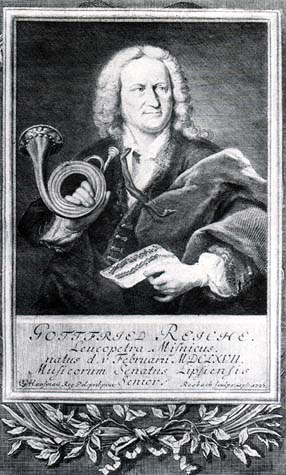
And, yet again, my father's adage applies: What you make on the bananas, you lose on the peanuts. The contemporary
reproduction of the portrait engraving that was derived accurately and precisely from the Haussmann painting is yet another
reminder that no such image of Sebastian Bach was published in his lifetime.
The print is dated 1727, and, in the absence of specific information about whether the original oil painting is signed and dated, I can
write only that the image was painted no later than year. Let us assume that it shows Reiche in 1727. He was then 60, just a year
younger than Bach when he sat for Haussmann in 1746. Let's begin this examination of the possibility that the Weydenhammer
Portrait Fragment might be the work of Elias Gottlob Haussmann by looking at some Weydenhammer Equivalents.
First, Gottfried Reiche and the Sebastian Bach of the 1748 Haussmann Portrait, and then immediately beneath that pair, Gottfried
Reiche and the Weydenhammer Portrait Fragment:

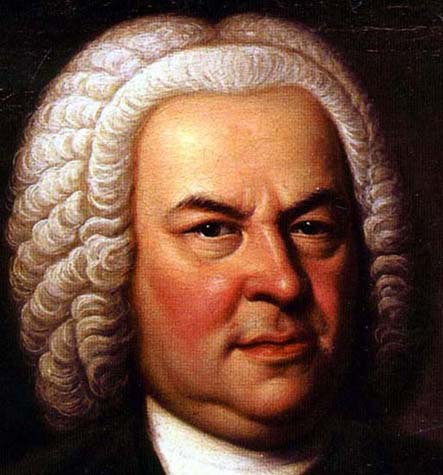

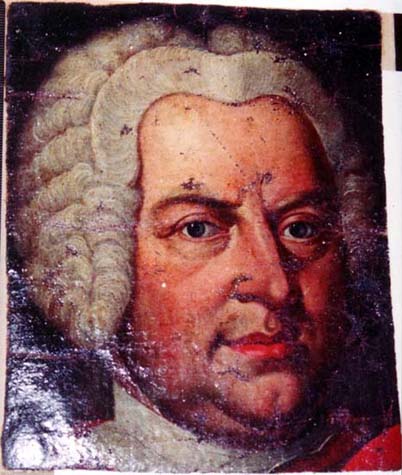
And, now, here are all three of them, with the Bach of the Weydenhammer Portrait Fragment and the Bach of the 1748 Haussmann
Portrait bracketing Gottfried Reiche:

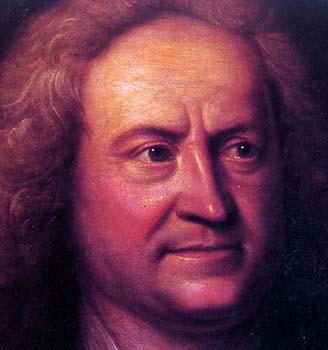
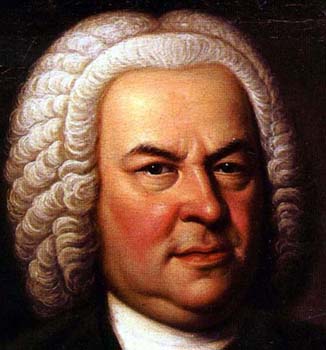
Even an unpracticed eye readily can see that the 1727 portrait of Gottfried Reiche stylistically has much more in common with the
1748 Haussmann Portrait than it does with the Weydenhammer Portrait Fragment, which was painted in the early 1730s. Clearly,
Haussmann's warm and smooth style changed little with the passage of time. The thing wasn't broke, and he didn't fix it.
That the Weydenhammer Portrait Fragment is not the handiwork of a younger Elias Gottlob Haussmann can be confirmed by the
direct comparison of the eyes and the mouth. The Weydenhammer Portrait Fragment is on the left, Haussmann's 1727 Portrait of
Reiche is on the right.

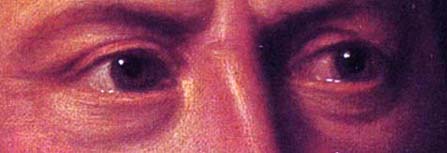
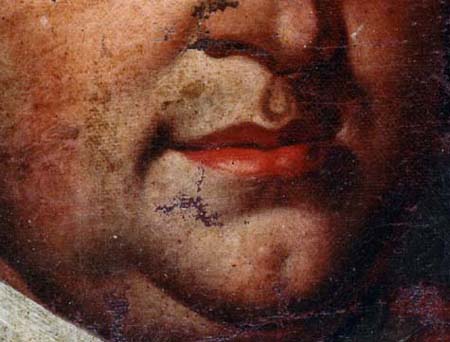
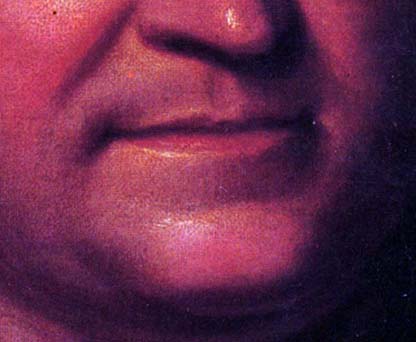
The anonymous limner who executed the Weydenhammer Portrait Fragment laid less paint down the canvas and used fewer, larger,
and crisper brush strokes with a much sharper delineation between light and shadow than Haussmann. A hallmark, it appears, of
Haussmann's portrait painting method is an image that is soft edged, as though on the borderline of out of focus. The aesthetic
philosophy of the so far anonymous portraitist who painted the Weydenhammer Portrait Fragment seems the very antithesis. In
fact, the sharpness of detail does suggest the possibility that the Weydenhammer Portrait Fragment might be, in fact, the work of
Balthasar Denner (1685-1749), who painted a portrait of Bach's friend and colleague, Silvius Leopold Weiss, a painting the present
whereabouts of which are unknown but which is the image from which the posthumous portrait engraving of Weiss was derived.

I admit that my knowledge of Denner's work is not all encompasssing, but, on the basis of my long "friendship" with the wonderful
bust portrait that Denner painted of Handel in 1728 or thereabouts that is now in the National Portrait Gallery in London, and, after
having studied Denner's magnificent bust portrait of an unidentified elderly lady that is now in the Hermitage Museum in St.
Petersburg, I have to say that, to me, the Weydenhammer Portrait Fragment shows a similar crispness and attention to detail, but I
also have to say that another Denner portrait, in the Tate Gallery in London, confirms the representation that his style changed over
the years, unlike Haussmann's. Obviously, I shall have to do a lot more research before I will risk attributing the Weydenhammer
Portrait Fragment to Denner, especially since the possibility that the image might be the handiwork of one the other prominent
portraitists then active in Germany, like Antoine Pesne and Louis de Silvestre, needs also to be considered.
That the Weydenhammer Portrait Fragment might be the work of Balthasar Denner is not without irony. First, if that turns out to be
the case, Denner would have painted both Bach and Handel within no more than eight years of one another. Second, Denner is
alleged by some (incorrectly, in my opinion) to have painted the Group Portrait that some allege, also incorrectly, to be a portrait of
Sebastian Bach and three of his sons.
That Elias Gottlob Haussmann is clearly not the painter of the Weydenhammer Portrait Fragment speaks powerfully in favor of the
painting's authenticity as an accurate depiction of the face of Johann Sebastian Bach, and one taken "ad visum". This younger,
thinner version of the familiar "Haussmann Face" is derived from no other image other than the face itself and what preliminary and
reference drawings the as yet unidentified portraitist may have made for his use while completing the portrait in oils.
Now, back to that laundry list of open questions about the the Weydenhammer Portrait Fragment:
Does a portrait in oils of Johann Sebastian Bach show up in any of the Weissenfels ducal inventories, either for the Augustusburg
or for the Dower House in Langensalza [and, as Christoph Wolff subsequently has pointed out, for Christian's Hunting Lodge as
well]?
If the painting was in the possession of the last Dowager Duchess of Weissenfels at the time of her death in 1775, who inherited it,
and where was it between 1775 and 1798, when it is assumed that Kittel received it as a gift from the four royals for whom he had
played the organ recital? And, if they did in fact present the painting to him then, how did the royals know that Kittel would want to
have the painting and how did they obtain it in order to give it to him?
Are there any materials in Ernst Ludwig Gerber's archives that shed further light on how Kittel acquired the painting?
Can it be determined who bought the painting at the auction of Kittel's estate, and, if so, can it be traced thereafter?
How did Hilgenfeldt know what the painting looked like, and, if he did not see the original himself, what was the source of his
information?
But no matter what the answers turn out to be, even if some of the answers contradict the anecdotal evidence on which we are
presently relying, one thing is certain:
The Weydenhammer Portrait Fragment is an accurate depiction of the face of Johann Sebastian Bach at an age significantly younger
than the ages at which he sat for Haussmann, and the Weydenhammer Portrait Fragment can be shown conclusively to meet all of
the requirements needed to match completely what we know about the anecdotal and documentary history, as well as the specifics
of the one known description, of the portrait of Bach that belonged to Kittel.
The re-emergence from the shadows of the Weydenhammer Portrait Fragment and its sure identification as the long lost portrait of
Bach that belonged to Kittel increase our knowledge of Bach the person immeasurably. Christoph Wolff has shown that the
Haussmann portraits epitomize Bach as he saw himself, the private Bach. The Weydenhammer Portrait Fragment is its perfect
companion and its perfect foil; it represents Bach as his world saw him, the public Bach.
I find that, even now, I can express my feelings about the Weydenhammer Portrait Fragment no better and no more effectively than
I did in the last paragraph of the letter that I wrote to Bill Scheide on April 13, 2000, when I sent him one of the 8x10s that I had had
Michael V. Cohen and New York Film Works make of that 4x6 snapshot that Erika Norwood had sent me less than two weeks
before:
As you can tell, I believe in this picture. Bernard Berenson said that the first ten seconds with an object were worth the
next ten years. Pictures tell different stories to different people, of course, but this painting speaks to me on a personal
and direct level. This is Bach, the Court Compositeur; this is Bach, the Capellmeister von Haus aus; this is Bach, the
proud father of a Dresden organist and of a member of the Prussian Crown Prince's household; this is the Bach of the
Collegium Musicum; this is the Bach of the Clavier-Übung.
I ask you now to recall one last time the words of Ernst Ludwig Gerber, as they were translated by Arthur Mendel in the 1966
Edition of The Bach Reader:
"As a special form of reward and punishment for his pupils [Kittel] used an oil painting of Joh[ann] Sebast[ian] Bach --
a fine likeness -- which he had recently acquired and hung over his clavier. If a pupil showed industry worthy of this
Father of Harmony, the curtain covering it was drawn aside. For the unworthy, on the other hand, Bach's countenance
remained hidden." (Mendel '66, pp. 425-426)
I truly do believe that, in whatever dimension they now reside, Johann Sebastian Bach and Johann Christian Kittel jointly determined
that a devoted pupil's industry has been worthy of this Father of Harmony, and that, for that reason, they decreed that it should
devolve upon me to have the privilege, the honor, and the joy of drawing back the curtain for the first time in 192 years.

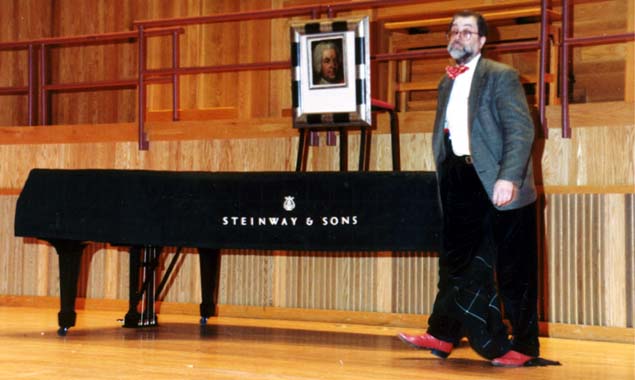
Photos by Nancy Bareis, ©2001, Queens College
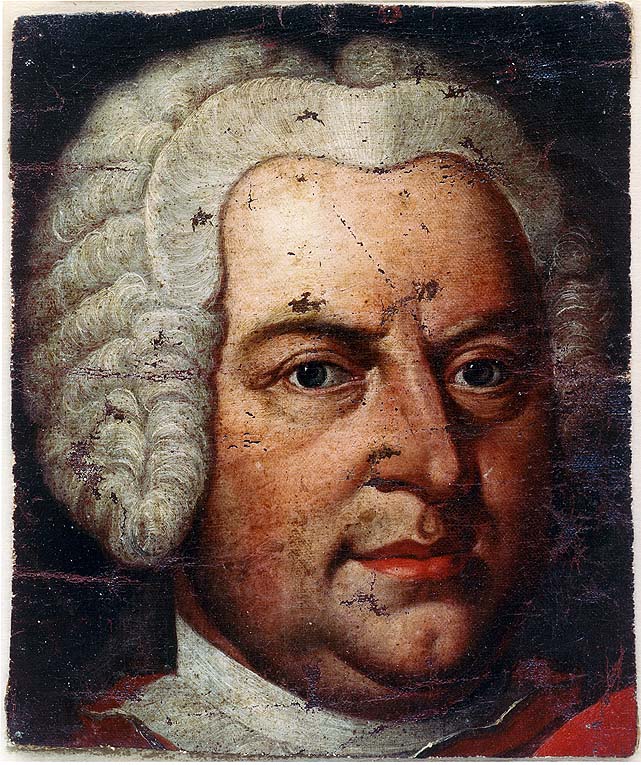
Thank you very much.
Please click on 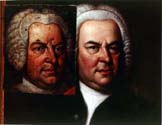 to advance to the Epilogue.
to advance to the Epilogue.
Please click on  to return to the Index Page at The Face Of Bach.
to return to the Index Page at The Face Of Bach.
Please click on  to visit the Johann Sebastian Bach Index Page at Teri Noel Towe's Homepages.
to visit the Johann Sebastian Bach Index Page at Teri Noel Towe's Homepages.
Please click on the  to visit the Teri Noel Towe Welcome Page.
to visit the Teri Noel Towe Welcome Page.
TheFaceOfBach@aol.com
Copyright, Teri Noel Towe, 2000 , 2002
Unless otherwise credited, all images of the Weydenhammer Portrait: Copyright, The Weydenhammer Descendants, 2000
All Rights Reserved
The Face Of Bach is a PPP Free Early Music website.

The Face Of Bach has received the HIP Woolly Mammoth Stamp of Approval from The HIP-ocrisy Home Page.